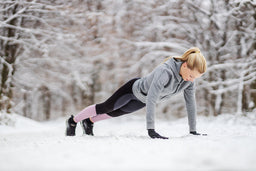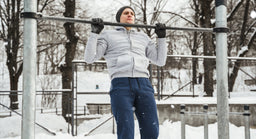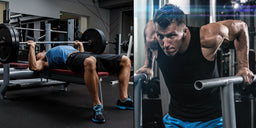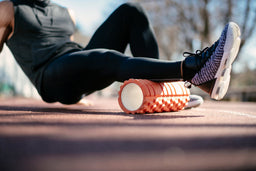
Gymnastic Rings: The ultimate tool for training anywhere
Gymnastic Rings: The ultimate tool for training anywhere
Do you have a garden? Does it have trees? Is there a kids climbing frame? Do you have scaffolding near you? Does your gym have a dedicated pull up bar, or climbing bars? Does your local park have goalposts? Or do you live near a calisthenics park? Or do you even have a Gravity Fitness Pull Up Rack in your home? You can use gymnastic rings anywhere! All you need is a solid horizontal bar to attach them to!
This is by far the best thing about gymnastic rings, regardless of the size of space you have, you can use gymnastic rings anywhere. You can throw them in your gym bag, take them outside to mix up your training sessions, or you can even take them on holiday. Trust me, there is nothing like doing a ring work session in the sun, looking out from a white sandy beach over the ocean.
Another reason gymnastic rings are so practical to train on is that, not only do they work all the planes of motion through full ranges, but they also bring the accessory muscles of any movement to the fore. This is because of destabilisation. Think of a dip as an example exercise; with a parallel bar dip your hands are fixed in a neutral grip, and you know when you dip down, your base isn’t going to move. However on the rings, that destabilisation creates work of other muscles; for example you can rotate your wrists during the eccentric part of the dip, adding grip and forearm strength. And you really have to focus to ensure you push back from a central position so that rings don’t buckle out underneath you. This is excellent for working our focus as well to ensure, you guessed it, full ROM and great form.
Now when it comes to a training session with the gymnastic rings, we can use fundamental push and pull movements through each plane of motion. For example, we have rows and push ups through the sagittal plane, we have pull ups and dips through the sagittal plane and through the frontal plane we can perform assisted split squats or archer movements. The gymnastic rings can cover the whole body in terms of a training session, and that’s even before we start to advance onto bodyweight skills.
We can use gymnastic rings to hone our strength in the end ranges, our balance and compression strength with flexibility. This is where the front lever, back lever, ring muscle up and, for those looking for a real challenge, planche, come into play. We can use the rings to work towards these goals. We can start to bring in bands, single leg negatives or tucks to slowly and steadily build up to these advanced skills. Gravity has plenty of great trainers on it’s roster for these skills, so go check out @gravity.fitness on Instagram to find out more.
So once you grab a set of rings, think about the goals you want to achieve. Are they more gymnastic in nature? Do they lean more towards strength? The versatility, popularity and portability of gymnastic rings mean you have plenty of sources you can draw inspiration from. Just remember, start at the bottom of the ladder. Keep working on those basics, even when you start to work on more advanced skills. Make sure you tie the rings, and fasten them up, securely before attempting any exercises. If you need a specific width for the rings to hold, make sure the excess strapping is tied up to ensure they don’t move.
What are you guys waiting for? Get those gymnastic rings and go out, do a session in the most exotic place/s you can, or just get started and let us know! Tag us @gravity.fitness so we can see where you’ve been and where you’re going on your gymnastic rings journey!
by Guy Joynson for Gravity Fitness
Raise The Game Fitness
Do you have a garden? Does it have trees? Is there a kids climbing frame? Do you have scaffolding near you? Does your gym have a dedicated pull up bar, or climbing bars? Does your local park have goalposts? Or do you live near a calisthenics park? Or do you even have a Gravity Fitness Pull Up Rack in your home? You can use gymnastic rings anywhere! All you need is a solid horizontal bar to attach them to!
This is by far the best thing about gymnastic rings, regardless of the size of space you have, you can use gymnastic rings anywhere. You can throw them in your gym bag, take them outside to mix up your training sessions, or you can even take them on holiday. Trust me, there is nothing like doing a ring work session in the sun, looking out from a white sandy beach over the ocean.
Another reason gymnastic rings are so practical to train on is that, not only do they work all the planes of motion through full ranges, but they also bring the accessory muscles of any movement to the fore. This is because of destabilisation. Think of a dip as an example exercise; with a parallel bar dip your hands are fixed in a neutral grip, and you know when you dip down, your base isn’t going to move. However on the rings, that destabilisation creates work of other muscles; for example you can rotate your wrists during the eccentric part of the dip, adding grip and forearm strength. And you really have to focus to ensure you push back from a central position so that rings don’t buckle out underneath you. This is excellent for working our focus as well to ensure, you guessed it, full ROM and great form.
Now when it comes to a training session with the gymnastic rings, we can use fundamental push and pull movements through each plane of motion. For example, we have rows and push ups through the sagittal plane, we have pull ups and dips through the sagittal plane and through the frontal plane we can perform assisted split squats or archer movements. The gymnastic rings can cover the whole body in terms of a training session, and that’s even before we start to advance onto bodyweight skills.
We can use gymnastic rings to hone our strength in the end ranges, our balance and compression strength with flexibility. This is where the front lever, back lever, ring muscle up and, for those looking for a real challenge, planche, come into play. We can use the rings to work towards these goals. We can start to bring in bands, single leg negatives or tucks to slowly and steadily build up to these advanced skills. Gravity has plenty of great trainers on it’s roster for these skills, so go check out @gravity.fitness on Instagram to find out more.
So once you grab a set of rings, think about the goals you want to achieve. Are they more gymnastic in nature? Do they lean more towards strength? The versatility, popularity and portability of gymnastic rings mean you have plenty of sources you can draw inspiration from. Just remember, start at the bottom of the ladder. Keep working on those basics, even when you start to work on more advanced skills. Make sure you tie the rings, and fasten them up, securely before attempting any exercises. If you need a specific width for the rings to hold, make sure the excess strapping is tied up to ensure they don’t move.
What are you guys waiting for? Get those gymnastic rings and go out, do a session in the most exotic place/s you can, or just get started and let us know! Tag us @gravity.fitness so we can see where you’ve been and where you’re going on your gymnastic rings journey!
by Guy Joynson for Gravity Fitness
































